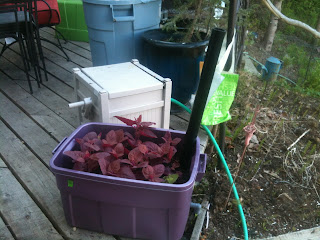06 02 12 First Fruits
In Alaska the three-day Memorial Day weekend is
traditionally planting time. By
the end of May the soil has thawed and those plants that thrive in the ground
can be planted. We have been right
on time this year, I suppose. Last
weekend was Memorial Day weekend, and we got most of our planting done, and I
am thrilled. It feels almost like
the first harvest, though we have only just planted. It’s just that it took a lot to get this year’s planting in,
and we did it!
In fact, we have been working hard for a long time to
prepare for this month’s planting.
Last June a number of our friends and acquaintances helped organize the Alaska Food Challenge. The idea was to participate as little
as possible in the inefficiencies that go along with getting most food in
Alaska. Participants in the Alaska
Food Challenge pledged either to avoid all food that is not produced in Alaska
(only a few were quite that hard core), or to take specific measures to
drastically reduce their consumption of food that is not Alaska grown. In our case, part of our pledge was to
begin creating the capability to grow enough produce, and harvest enough fish
and game, to be at least 67% food self-reliant beginning by September
2012.
 |
| Red Microgreens in an Earth Box |
Actually, this would mean we would have much to share, because we easily can grow more of some things, like potatoes, than we need. Also, we are trying to turn our bioshelter home into an experiment on how Alaskans can live well while causing minimal environmental impact. If we can gather ideas for this from our growing cadre of acquaintances, and put some of those ideas into practice, we hope that the fruits of our experiment will also be worth sharing.
Which brings me back to the realization that already we have
fruits—first fruits only, to be sure—but fruits to share.
According to the traditional Jewish calendar the festival of
Shavuot was the season for beginning to bring the First Fruits offerings to the
Temple. Shavuot began 50 days
after Passover, which means that we are fully into Shavuot now. Alaskans, of course, have a different
growing season than Palestine, so we have little to offer in this season as a
First Fruits harvest. However, if
part of our offering is to share what we are learning, and to show the simple
satisfaction that goes with planning a way of life and then seeing the plan
begin to work, then this blog is a part of sharing the first fruits.
In fact, sharing is a tradition with a long history in Alaska. Native American traditions in Alaska
lift up sharing as one of the key values for living properly in
relationships. I do not claim to fully understand the “sharing”
teaching from Native Americans, but I feel blessed even to meditate on the bits
I have learned. For now, let me
suggest that the value of sharing is at least related to the same virtues that
go into the offering of First Fruits.
 |
| Strawberry Plant in the Solarium |
This has been true for Cindee and me, too. We are employing any number of
techniques to make things work in our experiment-in-life we chose by living in
a bioshelter. However, all of
those ideas and techniques were given to us through the generous sharing of
ideas of friends and acquaintances.
We have benefited from others offering the fruits of their experience,
and we can do no less.
So, today the sun is shining. I will take a few pictures to share some of what we are
doing and put them in another post shortly (count the two in this blog as just tantalizers). We can at least share some of the ideas we are
employing. Whether or not these
ideas and techniques will truly result in food to share, however, is a question
that will have to wait until the Alaska harvest season.
I will also spend the day contemplating sharing of fruits. When sharing becomes a way of life, is it more a duty or a
joy?



Comments
Post a Comment